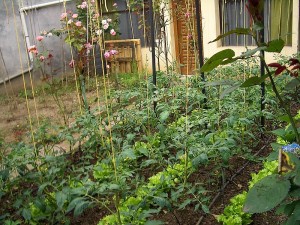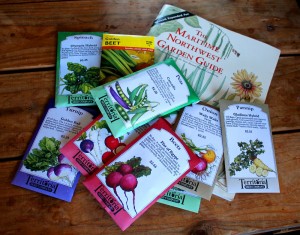Somehow Pagan Values Month crept up on me this year. Luckily, it caught me at a time when a good topic was percolating in my head: food.
Food may not seem much like a value, so much as a necessity. Unable to photosynthesize sunlight into energy, we animals must consume other living beings to get our nutrients, whether in the form of other animals or the photosynthesizers (plants) themselves. And despite efforts to create a one-size-fits-all convenience substitute for food (like this dreadful looking stuff here), we’re still largely reliant on the direct products of the Earth for our daily sustenance.
But we are human, and one of the things that (as far as we know) makes us unique is the control we have over our environments through our intelligence, resourcefulness, and nifty opposable thumbs. One of the many ways in which we exercise this is through our conscious choice of food. Particularly as we developed agriculture and gained more independence on our food supply, we’ve been able to decide whether or not to eat a particular thing, rather than eating whatever happened to be available at the time. And cooking is even older than agriculture, with the earliest evidence arising 250,000 or so years ago.
With cooking came even more diversity in flavors, and with that a greater appreciation for the aesthetics, rather than just the functionality, of food. We can enjoy food, not just because a particular taste lets us know it has good things in it, but because we are conscious of our enjoyment. We are capable of choosing the flavors we like best, combining them in unusual and surprising manners. And in that act of creation, we appreciate and celebrate the food and its goodness.

This goes for most pagans, too. When we have our “harvest” celebrations in late summer and fall, Lammas and Mabon and Samhain, most of us aren’t offering up food that we ourselves grew or raised. Instead, everyone brings things we bought from the store, the farmers and farms themselves left anonymous and forgotten. We come together because someone’s ancestors way back when celebrated the harvest around this time–or because some book explained the eight Sabbats and that’s what we figure we’re supposed to do. There’s an almost complete disconnect between the empty words we speak out of some book of shadows, and the people who actually raised and harvested the food we consume once the circle’s closed.
It is not enough to celebrate “Yay, food!” with bland words of “Thank you to the Earth, blah, blah, blah”. What does that really mean? Thank you, entire planet? Thank you, unidentified spot where this apple was grown? Thank you, soil where a migrant worker stepped as they picked this handful of peas?
For those pagans whose spirituality centers on nature, this is a potential area for a deeper connection to the land. We need to go beyond rote harvest celebrations. Just like a Christian doesn’t stop being Christian after the hour-long Sunday service is done, we don’t stop being nature pagans after everyone goes home from the Sabbat (or whatever your chosen celebration is). To really honor the land we get our food from, we have to know it. We have to remove the anonymity as best as we can. And we have to acknowledge the sources and systems that bring us our food every day, to include the harm they can bring to the environment and ourselves, and mitigate the damage as best as we can. If we’re going to claim to honor nature, it’s imperative that we go beyond the generic “thank you”.
This isn’t always as easy as it sounds. Gardening seems like the easiest and most immediate solution to the anonymous food and land problem; I’ve been growing vegetables since I moved to the Northwest in 2006. But it takes money and resources; there are times when all I had was a few pots on the porch, and some people don’t even have access to that. Few of us have enough land to grow enough food for the household year-round; my community garden plot is 10′ x 20′, and it’s a good week if I can pull a few salads for two from it.

Cost becomes a factor, too, when trying to buy more personal food. Big agriculture gets a ton of government subsidies which allow their products to be sold more cheaply; often the independent farmers can’t compete because they have to sell their food at real cost. This, unfortunately, can price it out of the reach of some people, especially those on lower incomes. This isn’t always universal; in the middle of summer I can go to the farmer’s market down the road and get a giant bundle of carrots for two bucks, but then pay $20/pound for grass-fed buffalo sirloin. (In which case, we just eat more carrots and only a little meat.)
The good news is that there’s no single right way to treat food as a pagan value. Just having more awareness of your food and where it comes from is a great starting point for breaking out of the generic “thank you, Earth!” form of food and land appreciation. As one example, even if all you know about the chickens your eggs came from is that they lived in tiny battery cages somewhere and existed only to lay as many eggs as possible, then at least you know who to really thank for your food at harvest time! And your awareness can lead to more conscious choices in the future, too. You might have access to free range eggs, whether through the grocery store or a farmer’s market. Even if you can’t buy the free range eggs every single shopping trip because they cost a few more dollars a dozen or because you’d have to travel farther for them, you might consider buying them once a month if you’re able, and that’s better than not buying them at all.
I’ll be talking more about issues surrounding food, sustainability, and their connection to spirituality in future posts–in fact, stay tuned for my next post where I’ll be reviewing a really good book that I’ve found incredibly inspirational in my quest to be a more responsible consumer of comestibles.




